Перевод и анализ слов искусственным интеллектом ChatGPT
На этой странице Вы можете получить подробный анализ слова или словосочетания, произведенный с помощью лучшей на сегодняшний день технологии искусственного интеллекта:
- как употребляется слово
- частота употребления
- используется оно чаще в устной или письменной речи
- варианты перевода слова
- примеры употребления (несколько фраз с переводом)
- этимология
Pacific angel shark - перевод на русский
общая лексика
калифорнийская скватина (Squatina californica)
Определение
Википедия

The Pacific angelshark (Squatina californica) is a species of angelshark, family Squatinidae, found in the eastern Pacific Ocean from Alaska to the Gulf of California, and from Ecuador to Chile, although those in the Gulf of California and southeastern Pacific may in fact be separate species. The Pacific angelshark inhabits shallow, coastal waters on sandy flats, usually near rocky reefs, kelp forests, or other underwater features. This species resembles other angel sharks in appearance, with a flattened body and greatly enlarged pectoral and pelvic fins. Characteristic features of this shark include a pair of cone-shaped barbels on its snout, angular pectoral fins, and a brown or gray dorsal coloration with many small dark markings. It attains a maximum length of 1.5 m (4.9 ft).
An ambush predator, the Pacific angelshark conceals itself on the sea floor and waits for approaching prey, primarily bony fishes and squid. Prey are targeted visually and, with a quick upward thrust of the head, snatched in protrusible jaws. Individual sharks actively choose ideal ambush sites, where they stay for several days before moving on to a new one. This species is more active at night than during the day, when it stays buried in sediment and seldom moves. Reproduction is ovoviviparous, with the embryos hatching inside the mother's uterus and being sustained by a yolk sac until birth. Females give birth to an average of six young every spring.
Pacific angelsharks are not dangerous to humans unless provoked, in which case their bite can cause a painful injury. They are valued for their meat and are captured by commercial and recreational fishers across their range. A targeted gillnet fishery for this species began off Santa Barbara, California in 1976 and ended in 1994, after overfishing and new regulations led to its near-collapse. This species is now mainly fished in Mexican waters. The International Union for Conservation of Nature (IUCN) has assessed this species as Near Threatened, as the Californian population is largely protected and recovering, while the impact of Mexican fisheries is unknown.






![Picture of the Pacific Ocean, taken from space by the [[Apollo 11]] crew in July 1969 Picture of the Pacific Ocean, taken from space by the [[Apollo 11]] crew in July 1969](https://commons.wikimedia.org/wiki/Special:FilePath/AS11-36-5349 (21514612649).jpg?width=200)
![Impact of [[El Niño]] and [[La Niña]] on North America Impact of [[El Niño]] and [[La Niña]] on North America](https://commons.wikimedia.org/wiki/Special:FilePath/El nino north american weather.png?width=200)
![Austronesian vessel]] with a double-canoe ([[catamaran]]) hull and a [[crab claw sail]] Austronesian vessel]] with a double-canoe ([[catamaran]]) hull and a [[crab claw sail]]](https://commons.wikimedia.org/wiki/Special:FilePath/Fijian double canoe, model, Otago Museum, 2016-01-29.jpg?width=200)
![thunderclouds]] are also visible. thunderclouds]] are also visible.](https://commons.wikimedia.org/wiki/Special:FilePath/Iss007e10807.jpg?width=200)
![[[Marine debris]] on a [[Hawaii]]an coast in 2008 [[Marine debris]] on a [[Hawaii]]an coast in 2008](https://commons.wikimedia.org/wiki/Special:FilePath/Marine debris on Hawaiian coast.jpg?width=200)
![[[Mount St. Helens]] in [[Skamania County, Washington]], U.S. in 2020 [[Mount St. Helens]] in [[Skamania County, Washington]], U.S. in 2020](https://commons.wikimedia.org/wiki/Special:FilePath/Mount Saint Helens, June 2020.jpg?width=200)


![The regions, island nations, and territories of [[Oceania]] The regions, island nations, and territories of [[Oceania]]](https://commons.wikimedia.org/wiki/Special:FilePath/Pacific Culture Areas.png?width=200)
![[[Tarawa Atoll]] in [[Kiribati]] [[Tarawa Atoll]] in [[Kiribati]]](https://commons.wikimedia.org/wiki/Special:FilePath/South Tarawa from the air.jpg?width=200)
![[[Abel Aubert du Petit-Thouars]] taking over [[Tahiti]] on 9 September 1842 [[Abel Aubert du Petit-Thouars]] taking over [[Tahiti]] on 9 September 1842](https://commons.wikimedia.org/wiki/Special:FilePath/TahitiDupetitThouars.jpg?width=200)
![Trieste]]'' before her record dive to the bottom of the [[Mariana Trench]], 23 January 1960 Trieste]]'' before her record dive to the bottom of the [[Mariana Trench]], 23 January 1960](https://commons.wikimedia.org/wiki/Special:FilePath/Trieste (23 Jan 1960).jpeg?width=200)
![[[Typhoon Tip]] at global peak intensity on 12 October 1979 [[Typhoon Tip]] at global peak intensity on 12 October 1979](https://commons.wikimedia.org/wiki/Special:FilePath/Typhoon Tip (1979) peak intensity.jpg?width=200)
![A [[stratovolcano]] in [[Ulawun]] on the island of [[New Britain]] in [[Papua New Guinea]] A [[stratovolcano]] in [[Ulawun]] on the island of [[New Britain]] in [[Papua New Guinea]]](https://commons.wikimedia.org/wiki/Special:FilePath/Ulawun.jpg?width=200)
![''Universalis Cosmographia'', also known as the [[Waldseemüller map]], dated 1507, was the first map to show the [[Americas]] separating two distinct oceans. South America was generally considered the [[New World]] and shows the name "America" for the first time, after [[Amerigo Vespucci]] ''Universalis Cosmographia'', also known as the [[Waldseemüller map]], dated 1507, was the first map to show the [[Americas]] separating two distinct oceans. South America was generally considered the [[New World]] and shows the name "America" for the first time, after [[Amerigo Vespucci]]](https://commons.wikimedia.org/wiki/Special:FilePath/Waldseemuller map 2.jpg?width=200)
![Diogo Ribeiro]] map was the first to show the Pacific at about its proper size Diogo Ribeiro]] map was the first to show the Pacific at about its proper size](https://commons.wikimedia.org/wiki/Special:FilePath/Carta universal en que se contiene todo lo que del mundo se ha descubierto fasta agora hizola Diego Ribero cosmographo de su magestad, ano de 1529, en Sevilla.jpg?width=200)

![Chocó natural region]] Chocó natural region]]](https://commons.wikimedia.org/wiki/Special:FilePath/Ladrilleros Beach Colombia.jpg?width=200)
![Tahuna maru islet, [[French Polynesia]] Tahuna maru islet, [[French Polynesia]]](https://commons.wikimedia.org/wiki/Special:FilePath/Tahuna maru islet Raroia.jpg?width=200)
